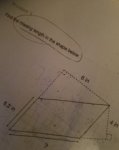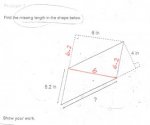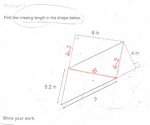You are using an out of date browser. It may not display this or other websites correctly.
You should upgrade or use an alternative browser.
You should upgrade or use an alternative browser.
Find the missing length in this shape
- Thread starter schicco
- Start date
mmm4444bot
Super Moderator
- Joined
- Oct 6, 2005
- Messages
- 10,902
Yes, I think we can find the missing length using the given information.Is everything complete in this question …
You have enough information to find the interior angles (not sure they're needed; I haven't worked the exercise). You can also use proportions from similar right triangles.
Have you tried anything, yet? :cool:
Thanks
Yes I tried doing that but the figure I am getting doesn't make sense; Can you try and see what you get.
Yes I tried doing that but the figure I am getting doesn't make sense; Can you try and see what you get.
Yes, I think we can find the missing length using the given information.
You have enough information to find the interior angles (not sure they're needed; I haven't worked the exercise). You can also use proportions from similar right triangles.
Have you tried anything, yet? :cool:
Here is what I came out with; so where do I go from here?
Thanks
Thanks
Yes, I think we can find the missing length using the given information.
You have enough information to find the interior angles (not sure they're needed; I haven't worked the exercise). You can also use proportions from similar right triangles.
Have you tried anything, yet? :cool:
Attachments
Here is what I came up with; where do I go from here?
Thanks
Thanks
Yes, I think we can find the missing length using the given information.
You have enough information to find the interior angles (not sure they're needed; I haven't worked the exercise). You can also use proportions from similar right triangles.
Have you tried anything, yet? :cool:
Attachments
Dr.Peterson
Elite Member
- Joined
- Nov 12, 2017
- Messages
- 16,051
Thanks
Yes I tried doing that but the figure I am getting doesn't make sense; Can you try and see what you get.
Please show specifically what you did, and tell us what doesn't make sense. Our goal is to help you figure it out, not just to give you the answer.
It appears necessary to assume that the shaded figure is a parallelogram. Are you told that? Given that, I see a process to get to the answer. (No angles are needed.
Thanks a lot
I assumed it's a parallelogram though it doesn't say. The question simply says "Find the missing length of shape below".
As you can see from attached I assumed opposite side of 6.2.in side is also 6.2 inch.
I then calculated to perimeter of that rectangular shape formation by (6.2x2) + (6x2)=24.4inch
Now I calculated the perimeter of each triangle in the rectangle by dividing the rectangle perimeter by 2 =12.2 inch
The two sides of the triangle are 6+6.2=12.2 inch
See attached
Steve
I assumed it's a parallelogram though it doesn't say. The question simply says "Find the missing length of shape below".
As you can see from attached I assumed opposite side of 6.2.in side is also 6.2 inch.
I then calculated to perimeter of that rectangular shape formation by (6.2x2) + (6x2)=24.4inch
Now I calculated the perimeter of each triangle in the rectangle by dividing the rectangle perimeter by 2 =12.2 inch
The two sides of the triangle are 6+6.2=12.2 inch
See attached
Steve
Please show specifically what you did, and tell us what doesn't make sense. Our goal is to help you figure it out, not just to give you the answer.
It appears necessary to assume that the shaded figure is a parallelogram. Are you told that? Given that, I see a process to get to the answer. (No angles are needed.
Attachments
Thanks a lot
I assumed it's a parallelogram though it doesn't say. The question simply says "Find the missing length of shape below".
As you can see from attached I assumed opposite side of 6.2.in side is also 6.2 inch.
I then calculated to perimeter of that rectangular shape formation by (6.2x2) + (6x2)=24.4inch
Now I calculated the perimeter of each triangle in the rectangle by dividing the rectangle perimeter by 2 =12.2 inch
The two sides of the triangle are 6+6.2=12.2 inch
See attached
Steve
pathagorean theorem?
Dr.Peterson
Elite Member
- Joined
- Nov 12, 2017
- Messages
- 16,051
Thanks a lot
I assumed it's a parallelogram though it doesn't say. The question simply says "Find the missing length of shape below".
As you can see from attached I assumed opposite side of 6.2.in side is also 6.2 inch.
I then calculated to perimeter of that rectangular shape formation by (6.2x2) + (6x2)=24.4inch
Now I calculated the perimeter of each triangle in the rectangle by dividing the rectangle perimeter by 2 =12.2 inch
The two sides of the triangle are 6+6.2=12.2 inch
The perimeter of a rectangle is not the sum of the perimeters of the two triangles that comprise it; as you can see in the way you calculated it, it is the sum of only the legs of the triangles, not the diagonals. Perimeters do not add up the way areas do.
Also, the red line you drew in is not justified by the problem; nothing says that that diagonal of the parallelogram is perpendicular to the sides, and so parallel to the 6. Never make assumptions like that. (In fact, this doesn't look true in the picture.)
All you need is to see that the two right triangles are similar; can you see what angles must be congruent, so you can conclude that? Then just make a proportion and you have the answer!
Yes I had figured out my mistake of assuming the perimeter of two triangles is equal to the rectangle.
Thanks I used proportion and it worked!
Thanks I used proportion and it worked!
The perimeter of a rectangle is not the sum of the perimeters of the two triangles that comprise it; as you can see in the way you calculated it, it is the sum of only the legs of the triangles, not the diagonals. Perimeters do not add up the way areas do.
Also, the red line you drew in is not justified by the problem; nothing says that that diagonal of the parallelogram is perpendicular to the sides, and so parallel to the 6. Never make assumptions like that. (In fact, this doesn't look true in the picture.)
All you need is to see that the two right triangles are similar; can you see what angles must be congruent, so you can conclude that? Then just make a proportion and you have the answer!




